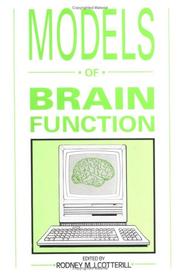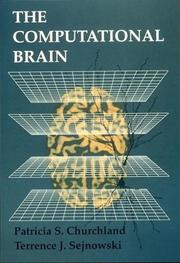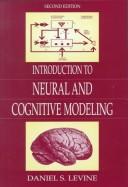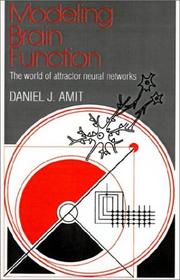| Listing 1 - 10 of 11 | << page >> |
Sort by
|

ISBN: 0521385032 Year: 1989 Publisher: Cambridge New York Sydney Cambridge University Press
Abstract | Keywords | Export | Availability | Bookmark
 Loading...
Loading...Choose an application
- Reference Manager
- EndNote
- RefWorks (Direct export to RefWorks)
Developmental psychology --- Circuitry [Neural ] --- Circuits [Neural ] --- Nerve net --- Nerve network --- Nerveux [Réseau ] --- Net [Zenuw] --- Neural circuitry --- Neural circuits --- Neural computers --- Neurale computers --- Neurocircuitry --- Neuronal circuitry --- Ordinateurs neuraux --- Réseau nerveux --- Zenuwnet --- Brain --- Computer simulation --- Brain - Computer simulation. --- Neural circuitry. --- Neural computers.

ISBN: 0262531208 0262031884 0262270293 0585038759 9780262270298 9780585038759 9780262031882 9780262339650 026233965X 9780262531207 9780262533393 0262533391 0262339668 Year: 1992 Publisher: Cambridge (Mass.): MIT Press,
Abstract | Keywords | Export | Availability | Bookmark
 Loading...
Loading...Choose an application
- Reference Manager
- EndNote
- RefWorks (Direct export to RefWorks)
An anniversary edition of the classic work that influenced a generation of neuroscientists and cognitive neuroscientists.Before The Computational Brain was published in 1992, conceptual frameworks for brain function were based on the behavior of single neurons, applied globally. In The Computational Brain, Patricia Churchland and Terrence Sejnowski developed a different conceptual framework, based on large populations of neurons. They did this by showing that patterns of activities among the units in trained artificial neural network models had properties that resembled those recorded from populations of neurons recorded one at a time. It is one of the first books to bring together computational concepts and behavioral data within a neurobiological framework. Aimed at a broad audience of neuroscientists, computer scientists, cognitive scientists, and philosophers, The Computational Brain is written for both expert and novice. This anniversary edition offers a new preface by the authors that puts the book in the context of current research.This approach influenced a generation of researchers. Even today, when neuroscientists can routinely record from hundreds of neurons using optics rather than electricity, and the 2013 White House BRAIN initiative heralded a new era in innovative neurotechnologies, the main message of The Computational Brain is still relevant.
#TELE:MI2 --- Circuitry [Neural ] --- Circuits [Neural ] --- Nerveux [Réseau ] --- Net [Zenuw] --- Neurale netwerken (Informatica) --- Réseau nerveux --- Réseaux neuraux (Informatique) --- Zenuwnet --- Models, Neurological --- Models of computation: automata; bounded action devices; computability theory; relations among models; self-modifying machines; unbounded-action devices--See also {681.3*F41} --- Computer Simulation. --- Models, Neurological. --- 681.3*F11 Models of computation: automata; bounded action devices; computability theory; relations among models; self-modifying machines; unbounded-action devices--See also {681.3*F41} --- Artificial intelligence. Robotics. Simulation. Graphics --- Computer architecture. Operating systems --- Brain --- Neural networks (Neurobiology) --- 681.3*F11 --- Biological neural networks --- Nets, Neural (Neurobiology) --- Networks, Neural (Neurobiology) --- Neural nets (Neurobiology) --- Cognitive neuroscience --- Neurobiology --- Neural circuitry --- Cerebrum --- Mind --- Central nervous system --- Head --- Computer simulation --- Computer Simulation --- Neurosciences --- physiology --- methods --- Neural networks (Neurobiology). --- Computer simulation. --- physiology. --- methods. --- Brain - Computer simulation. --- Neural networks (Computer science) --- Neural circuitry. --- Physiology. --- Methods. --- Brain - physiology --- Neurosciences - methods --- Brain - Computer simulation --- NEUROSCIENCE/General --- COGNITIVE SCIENCES/General

ISBN: 0805802673 0805802681 9780805802689 Year: 1991 Publisher: Hillsdale (N.J.): Erlbaum, Lawrence, Associates,
Abstract | Keywords | Export | Availability | Bookmark
 Loading...
Loading...Choose an application
- Reference Manager
- EndNote
- RefWorks (Direct export to RefWorks)
Cognitive psychology --- Artificial intelligence. Robotics. Simulation. Graphics --- Brain --- Cognition --- Neural networks (Computer science) --- Cerveau --- Réseaux neuronaux (Informatique) --- Computer simulation --- Simulation par ordinateur --- Computer simulation. --- Neural networks (Computer science). --- Réseaux neuronaux (Informatique) --- Artificial neural networks --- Nets, Neural (Computer science) --- Networks, Neural (Computer science) --- Neural nets (Computer science) --- Artificial intelligence --- Natural computation --- Soft computing --- Psychology --- Cerebrum --- Mind --- Central nervous system --- Head --- Brain - Computer simulation --- Cognition - Computer simulation

ISBN: 0521421241 9780521421249 Year: 1992 Publisher: Cambridge: Cambridge university press,
Abstract | Keywords | Export | Availability | Bookmark
 Loading...
Loading...Choose an application
- Reference Manager
- EndNote
- RefWorks (Direct export to RefWorks)
Fysiologie [Neuro] --- Modellen [Neurologische ] --- Models [Neurological ] --- Modèles neurologiques --- Nervous system--Physiology --- Neurale netwerken (Informatica) --- Physiology [Neuro] --- Réseaux neuraux (Informatique) --- Models, Neurological --- Nervalous System --- Ordinateurs neuronaux --- Models, Neurological. --- Brain --- Neural computers --- Neural networks (Computer science) --- Cerveau --- Réseaux neuronaux (Informatique) --- physiology --- Computer simulation --- Simulation par ordinateur --- Nervous System Physiological Phenomena. --- #TELE:SISTA --- Nervous System Physiological Concepts --- Nervous System Physiological Phenomenon --- Nervous System Physiological Process --- Physiology, Nervous System --- Nervous System Physiologic Processes --- Nervous System Physiological Processes --- Nervous System Physiology --- System Physiology, Nervous --- Nervous System --- Model, Neurological --- Neurologic Model --- Neurological Model --- Neurological Models --- Neurologic Models --- Model, Neurologic --- Models, Neurologic --- Neurophysiology --- Brain - Computer simulation. --- Neural computers. --- Nervous System - physiology. --- Nervous System Physiological Phenomena

ISBN: 0521361001 9780521361002 9780511623257 9780521421249 Year: 1989 Publisher: Cambridge: Cambridge university press,
Abstract | Keywords | Export | Availability | Bookmark
 Loading...
Loading...Choose an application
- Reference Manager
- EndNote
- RefWorks (Direct export to RefWorks)
Statistical physics --- Brain --- Neural networks (Neurobiology) --- Neural computers --- Models, Neurological --- Nervous System Physiological Phenomena --- Computer simulation --- Models, Neurological. --- Nervous System Physiological Phenomena. --- -Neural computers. --- Biological neural networks --- Nets, Neural (Neurobiology) --- Networks, Neural (Neurobiology) --- Neural nets (Neurobiology) --- Cognitive neuroscience --- Neurobiology --- Neural circuitry --- Neural net computers --- Neural network computers --- Neurocomputers --- Electronic digital computers --- Natural computation --- Artificial intelligence --- Cerebrum --- Mind --- Central nervous system --- Head --- Nervous System Physiological Concepts --- Nervous System Physiological Phenomenon --- Physiology, Nervous System --- Nervous System Physiology --- System Physiology, Nervous --- Nervous System --- Model, Neurological --- Neurologic Model --- Neurological Model --- Neurological Models --- Neurologic Models --- Model, Neurologic --- Models, Neurologic --- physiology --- Neural computers. --- Computer simulation. --- physiology. --- Nervous System Physiological Process --- Nervous System Physiologic Processes --- Nervous System Physiological Processes --- Neural networks (Neurobiology). --- Physiology. --- Brain - Computer simulation
Book
ISBN: 1461425506 1441907955 9786612831195 1441907963 1282831194 Year: 2010 Publisher: New York : Springer,
Abstract | Keywords | Export | Availability | Bookmark
 Loading...
Loading...Choose an application
- Reference Manager
- EndNote
- RefWorks (Direct export to RefWorks)
Foreword by Walter J. Freeman. The induction of unconsciousness using anesthetic drugs demonstrates that the cerebral cortex can operate in two very different modes: alert and responsive versus unaware and quiescent. But the states of wakefulness and sleep are not single-neuron properties---they emerge as bulk properties of cooperating populations of neurons, with the switchover between states being similar to the physical change of phase observed when water freezes or ice melts. Some brain-state transitions, such as sleep cycling, anesthetic induction, epileptic seizure, are obvious and detected readily with a few EEG electrodes; others, such as the emergence of gamma rhythms during cognition, or the ultra-slow BOLD rhythms of relaxed free-association, are much more subtle. The unifying theme of this book is the notion that all of these bulk changes in brain behavior can be treated as phase transitions between distinct brain states. "Modeling Phase Transitions in the Brain" contains chapter contributions from leading researchers who apply state-space methods, network models, and biophysically-motivated continuum approaches to investigate a range of neuroscientifically relevant problems that include analysis of nonstationary EEG time-series; network topologies that limit epileptic spreading; saddle--node bifurcations for anesthesia, sleep-cycling, and the wake--sleep switch; prediction of dynamical and noise-induced spatiotemporal instabilities underlying BOLD, alpha-, and gamma-band EEG oscillations, gap-junction-moderated Turing structures, and Hopf--Turing interactions leading to cortical waves. Written for: Researchers, clinicians, physicians, neurologists About the editors: Alistair Steyn-Ross and Moira Steyn-Ross are computational and theoretical physicists in the Department of Engineering, University of Waikato, New Zealand. They share a long-standing interest in the application of physics-based methods to gain insight into the emergent behavior of complex biological systems such as single neurons and interacting neural populations.
Brain. --- Brain -- Computer simulation. --- Brain --- Physical Processes --- Cognition --- Nervous System Physiological Processes --- Psychophysiology --- Central Nervous System --- Diagnostic Imaging --- Physicochemical Processes --- Diagnostic Techniques, Neurological --- Models, Theoretical --- Investigative Techniques --- Phase Transition --- Brain Mapping --- Models, Psychological --- Consciousness --- Sleep --- Nervous System Physiological Phenomena --- Chemical Processes --- Diagnostic Techniques and Procedures --- Analytical, Diagnostic and Therapeutic Techniques and Equipment --- Physical Phenomena --- Psychological Phenomena and Processes --- Nervous System --- Mental Processes --- Physicochemical Phenomena --- Psychiatry and Psychology --- Chemical Phenomena --- Musculoskeletal and Neural Physiological Phenomena --- Diagnosis --- Phenomena and Processes --- Anatomy --- Human Anatomy & Physiology --- Medicine --- Neurology --- Neuroscience --- Health & Biological Sciences --- Computer simulation --- Neurophysiology. --- Computer simulation. --- Nervous system --- Cerebrum --- Mind --- Physiology --- Medicine. --- Neurosciences. --- Anesthesiology. --- Neurology. --- Bioinformatics. --- Computational biology. --- Neurobiology. --- Medicine & Public Health. --- Computer Appl. in Life Sciences. --- Neurobiology --- Central nervous system --- Head --- Biology --- Data processing. --- Neurosciences --- Anaesthesiology --- Surgery --- Neural sciences --- Neurological sciences --- Medical sciences --- Neuropsychiatry --- Diseases --- Neurology . --- Bioinformatics . --- Computational biology . --- Bioinformatics --- Bio-informatics --- Biological informatics --- Information science --- Computational biology --- Systems biology --- Data processing
Book
ISBN: 1441999965 1441999973 Year: 2011 Publisher: New York : Springer,
Abstract | Keywords | Export | Availability | Bookmark
 Loading...
Loading...Choose an application
- Reference Manager
- EndNote
- RefWorks (Direct export to RefWorks)
The mechanical properties of living tissues continue to be the major topic of biomechanical investigations. Most researchers have investigated load-bearing tissues, such as bones, ligaments, muscles and other components of the musculoskeletal system, blood vessels (and blood), lungs, skin and hair. Until recently, very soft tissues of organs whose role has little or nothing to do with transmitting mechanical loads have been outside the scope of the mainstream biomechanical research. These “neglected” organs include the liver, kidneys, prostate and other abdominal organs, and especially the brain. Increased interest in the biomechanics of soft tissues, particularly the brain, as evidenced by the increased number of publications in this area, has motivated this effort to summarize recent developments. Biomechanics of the Brain will take the reader to the forefront of current research. Covering topics from brain anatomy and imaging to sophisticated methods of modeling brain injury and neurosurgery, to the cutting edge methods in analyzing cerebrospinal fluid and blood flow, this book is the first comprehensive reference in the field of biomechanics of the brain. Experienced biomechanics researchers as well as those new to the field will find parts of this book useful.
Biomechanics. --- Brain -- Computer simulation. --- Brain. --- Cognitive psychology. --- Cognitive science. --- Brain --- Biomechanics --- Investigative Techniques --- Diagnostic Techniques, Neurological --- Brain Diseases --- Analytical, Diagnostic and Therapeutic Techniques and Equipment --- Craniocerebral Trauma --- Mechanical Phenomena --- Biological Science Disciplines --- Diagnostic Imaging --- Central Nervous System --- Biophysical Phenomena --- Models, Biological --- Trauma, Nervous System --- Models, Theoretical --- Physical Phenomena --- Wounds and Injuries --- Natural Science Disciplines --- Diagnostic Techniques and Procedures --- Central Nervous System Diseases --- Nervous System --- Nervous System Diseases --- Phenomena and Processes --- Diseases --- Anatomy --- Disciplines and Occupations --- Brain Mapping --- Brain Injuries --- Models, Neurological --- Diagnosis --- Methods --- Physiology --- Medicine --- Biology --- Health & Biological Sciences --- Biophysics --- Neurology --- Imaging --- Imaging. --- Biological mechanics --- Mechanical properties of biological structures --- Physics. --- Neurosurgery. --- Biophysics. --- Biological physics. --- Biomedical engineering. --- Biophysics and Biological Physics. --- Biomedical Engineering. --- Mechanics --- Contractility (Biology) --- Biological and Medical Physics, Biophysics. --- Biomedical Engineering and Bioengineering. --- Nerves --- Neurosurgery --- Clinical engineering --- Medical engineering --- Bioengineering --- Engineering --- Surgery --- Biological physics --- Medical sciences --- Physics
Book
ISBN: 146142562X 1441909958 9786612830921 1441909966 1282830929 Year: 2010 Publisher: New York : Springer,
Abstract | Keywords | Export | Availability | Bookmark
 Loading...
Loading...Choose an application
- Reference Manager
- EndNote
- RefWorks (Direct export to RefWorks)
The hippocampus plays an indispensable role in the formation of new memories in the mammalian brain. It is the focus of intense research and our understanding of its physiology, anatomy, and molecular structure has rapidly expanded in recent years. Yet, still much needs to be done to decipher how hippocampal microcircuits are built and function. Here, we present an overview of our current knowledge and a snapshot of ongoing research into these microcircuits. Rich in detail, Hippocampal Microcircuits: A Computational Modeler’s Resource Book provides focused and easily accessible reviews on various aspects of the theme. It is an unparalleled resource of information, including both data and techniques that will be an invaluable companion to all those wishing to develop computational models of hippocampal neurons and neuronal networks. The book is divided into two main parts. In the first part, leading experimental neuroscientists discuss data on the electrophysiological, neuroanatomical, and molecular characteristics of hippocampal circuits. The various types of excitatory and inhibitory neurons are reviewed along with their connectivity and synaptic properties. Single cell and ensemble activity patterns are presented from in vitro models, as well as anesthetized and freely moving animals. In the second part, computational neuroscientists describe models of hippocampal microcircuits at various levels of complexity, from single neurons to large-scale networks. Additionally, a chapter is devoted to simulation environments currently used by computational neuroscientists in developing their models. In addition to providing concise reviews and a wealth of data, the chapters also identify central questions and unexplored areas that will define future research in computational neuroscience. About the Editors: Dr. Vassilis Cutsuridis is a Research Fellow in the Department of Computing Science and Mathematics at the University of Stirling, Scotland, UK. Dr. Bruce P. Graham is a Reader in Computing Science in the Department of Computing Science and Mathematics at the University of Stirling. Dr. Stuart Cobb and Dr. Imre Vida are Senior Lecturers in the Neuroscience and Molecular Pharmacology Department at the University of Glasgow, Scotland, UK.
Hippocampus (Brain) -- Computer simulation. --- Neural networks (Neurobiology) -- Computer simulation. --- Hippocampus (Brain) --- Neural networks (Neurobiology) --- Nervous System --- Electrophysiological Processes --- Signal Transduction --- Computing Methodologies --- Limbic System --- Biological Science Disciplines --- Cerebral Cortex --- Models, Biological --- Nervous System Physiological Processes --- Synaptic Transmission --- Physiology --- Computer Simulation --- Nerve Net --- Models, Neurological --- Hippocampus --- Neural Pathways --- Biochemical Processes --- Nervous System Physiological Phenomena --- Cerebrum --- Electrophysiological Phenomena --- Physiological Processes --- Anatomy --- Models, Theoretical --- Cell Physiological Processes --- Brain --- Information Science --- Natural Science Disciplines --- Chemical Processes --- Physiological Phenomena --- Disciplines and Occupations --- Biochemical Phenomena --- Central Nervous System --- Cell Physiological Phenomena --- Investigative Techniques --- Telencephalon --- Musculoskeletal and Neural Physiological Phenomena --- Chemical Phenomena --- Phenomena and Processes --- Prosencephalon --- Analytical, Diagnostic and Therapeutic Techniques and Equipment --- Human Anatomy & Physiology --- Medicine --- Neurology --- Neuroscience --- Health & Biological Sciences --- Computer simulation --- Computer simulation. --- Biological neural networks --- Nets, Neural (Neurobiology) --- Networks, Neural (Neurobiology) --- Neural nets (Neurobiology) --- Ammon's horn --- Cornu ammonis --- Medicine. --- Neurosciences. --- Bioinformatics. --- Computational biology. --- Neurobiology. --- Biomedicine. --- Computer Appl. in Life Sciences. --- Neurosciences --- Biology --- Bioinformatics --- Bio-informatics --- Biological informatics --- Information science --- Computational biology --- Systems biology --- Neural sciences --- Neurological sciences --- Medical sciences --- Nervous system --- Clinical sciences --- Medical profession --- Human biology --- Life sciences --- Pathology --- Physicians --- Data processing --- Cognitive neuroscience --- Neurobiology --- Neural circuitry --- Cerebral cortex --- Limbic system --- Data processing. --- Bioinformatics . --- Computational biology .
Book
ISBN: 038788629X 9786612927935 1282927930 0387886303 Year: 2010 Publisher: New York : Springer,
Abstract | Keywords | Export | Availability | Bookmark
 Loading...
Loading...Choose an application
- Reference Manager
- EndNote
- RefWorks (Direct export to RefWorks)
The human brain is among the most complex systems known to mankind. Neuroscientists seek to understand brain function through detailed analysis of neuronal excitability and synaptic transmission. Only in the last few years has it become feasible to capture simultaneous responses from a large enough number of neurons to empirically test the theories of human brain function computationally. This book is comprised of state-of-the-art experiments and computational techniques that provide new insights and improve our understanding of the human brain. This volume includes contributions from diverse disciplines including electrical engineering, biomedical engineering, industrial engineering, and medicine, bridging a vital gap between the mathematical sciences and neuroscience research. Covering a wide range of research topics, this volume demonstrates how various methods from data mining, signal processing, optimization and cutting-edge medical techniques can be used to tackle the most challenging problems in modern neuroscience. The results presented in this book are of great interest and value to scientists, graduate students, researchers and medical practitioners interested in the most recent developments in computational neuroscience.
Brain -- Computer simulation. --- Brain -- physiology. --- Computer Simulation. --- Models, Neurological. --- Neural networks (Neurobiology). --- Neurosciences -- methods. --- Computational neuroscience --- Investigative Techniques --- Models, Biological --- Biological Science Disciplines --- Biology --- Models, Neurological --- Methods --- Neurosciences --- Computational Biology --- Natural Science Disciplines --- Models, Theoretical --- Analytical, Diagnostic and Therapeutic Techniques and Equipment --- Disciplines and Occupations --- Mathematics --- Human Anatomy & Physiology --- Neuroscience --- Mathematics - General --- Health & Biological Sciences --- Physical Sciences & Mathematics --- Computational neuroscience. --- Computational neurosciences --- Medicine. --- Neurosciences. --- Health informatics. --- Computer mathematics. --- Mathematical models. --- Biomedical engineering. --- Biomedicine. --- Health Informatics. --- Biomedical Engineering. --- Computational Mathematics and Numerical Analysis. --- Mathematical Modeling and Industrial Mathematics. --- Computational biology --- Medical records --- Computer science --- Biomedical Engineering and Bioengineering. --- Data processing. --- Mathematics. --- Computer mathematics --- Discrete mathematics --- Electronic data processing --- Clinical engineering --- Medical engineering --- Bioengineering --- Biophysics --- Engineering --- Medicine --- EHR systems --- EHR technology --- EHRs (Electronic health records) --- Electronic health records --- Electronic medical records --- EMR systems --- EMRs (Electronic medical records) --- Information storage and retrieval systems --- Neural sciences --- Neurological sciences --- Medical sciences --- Nervous system --- Medical care --- Models, Mathematical --- Simulation methods --- Clinical informatics --- Health informatics --- Medical information science --- Information science --- Data processing
Book
ISBN: 3211094504 9786612826009 3211094512 128282600X Year: 2009 Publisher: Wien ; New York : Springer,
Abstract | Keywords | Export | Availability | Bookmark
 Loading...
Loading...Choose an application
- Reference Manager
- EndNote
- RefWorks (Direct export to RefWorks)
Can psychoanalysis offer a new computer model? Can computer designers help psychoanalysts to understand their theory better?In contemporary publications human psyche is often related to neural networks. Why? The wiring in computers can also be related to application software. But does this really make sense? Artificial Intelligence has tried to implement functions of human psyche. The reached achievements are remarkable; however, the goal to get a functional model of the mental apparatus was not reached. Was the selected direction incorrect?The editors are convinced: yes, and they try to give answers here. If one accepts that the brain is an information processing system, then one also has to accept that computer theories can be applied to the brain’s functions, the human mental apparatus. The contributors of this book - Solms, Panksepp, Sloman and many others who are all experts in computer design, psychoanalysis and neurology are united in one goal: finding synergy in their interdisciplinary fields.
Artificial intelligence. --- Brain --Computer simulation. --- Neural networks (Computer science). --- Neural networks (Neurobiology). --- Artificial intelligence --- Neural networks (Neurobiology) --- Neural networks (Computer science) --- Brain --- Computer Science --- Mechanical Engineering - General --- Mechanical Engineering --- Engineering & Applied Sciences --- Computer simulation --- Information Technology --- Artificial Intelligence --- Computer simulation. --- Biological neural networks --- Nets, Neural (Neurobiology) --- Networks, Neural (Neurobiology) --- Neural nets (Neurobiology) --- Artificial neural networks --- Nets, Neural (Computer science) --- Networks, Neural (Computer science) --- Neural nets (Computer science) --- Cerebrum --- Mind --- AI (Artificial intelligence) --- Artificial thinking --- Electronic brains --- Intellectronics --- Intelligence, Artificial --- Intelligent machines --- Machine intelligence --- Thinking, Artificial --- Computer science. --- Psychoanalysis. --- User interfaces (Computer systems). --- Control engineering. --- Robotics. --- Mechatronics. --- Neuropsychology. --- Cognitive psychology. --- Computer Science. --- Artificial Intelligence (incl. Robotics). --- Control, Robotics, Mechatronics. --- Cognitive Psychology. --- User Interfaces and Human Computer Interaction. --- Bionics --- Cognitive science --- Digital computer simulation --- Electronic data processing --- Logic machines --- Machine theory --- Self-organizing systems --- Simulation methods --- Fifth generation computers --- Neural computers --- Cognitive neuroscience --- Neurobiology --- Neural circuitry --- Natural computation --- Soft computing --- Central nervous system --- Head --- Psychology, clinical. --- Consciousness. --- Artificial Intelligence. --- Informatics --- Science --- Apperception --- Mind and body --- Perception --- Philosophy --- Psychology --- Spirit --- Self --- Psychology, Pathological --- Interfaces, User (Computer systems) --- Human-machine systems --- Human-computer interaction --- Psychology, Cognitive --- Mechanical engineering --- Microelectronics --- Microelectromechanical systems --- Automation --- Control engineering --- Control equipment --- Control theory --- Engineering instruments --- Programmable controllers --- Neurophysiology --- Psychophysiology
| Listing 1 - 10 of 11 | << page >> |
Sort by
|

 Search
Search Feedback
Feedback About UniCat
About UniCat  Help
Help News
News